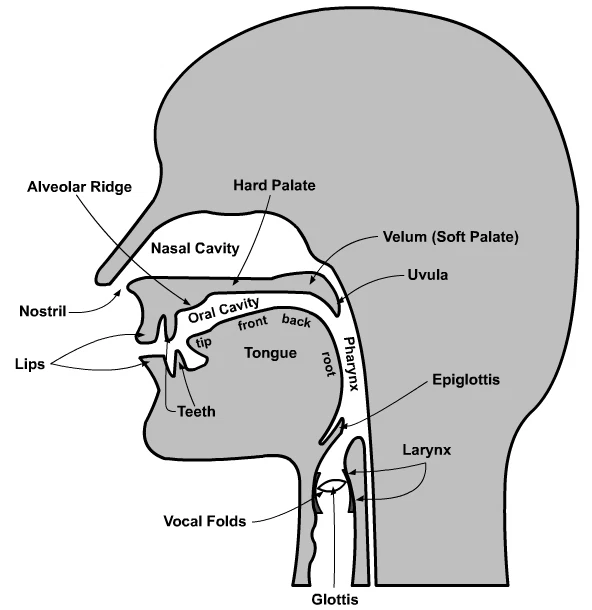Topic Content:
- The Organs of Speech
- Evaluation Questions
The process of speech production begins when air leaves the lungs into the throat. In the throat, the air passes through the vocal cords, which close or open, giving rise to a particular type of sound.
The next location is the mouth where we have the tongue, teeth, and lips. These are called articulators. The most mobile of all the articulators is the tongue and mobility determines how sounds are made. The tongue assumes different positions and shapes as one speaks.
These positions include the lips, the teeth, the hard alveolar ridge directly behind the teeth, and the long, concave roof of the mouth, called the palate made up of the hard palate and velum, also called the soft palate.
For most sounds the velum closes the passage into the nasal cavity, but for nasal sounds, the passage is left open so that air can resonate there.

Speech Organs in English:
1. Lips:
Both the upper lips and the lower lips are considered important apparatus in producing a speech sound and they can take different shapes and positions. The lower lip can touch the upper lip or make contact with the teeth.
2. Teeth:
Both the upper teeth and lower teeth are used in producing sounds like /ð/ – they, and /θ/ – thought.
3. Tongue:
The tongue is effective in moving in different directions or shapes quickly, in order to make speech sounds. It is considered the most important organ of speech. The tongue is divided into different parts, including:
- Tip
- Blade
- Front
- Back
- Root
4. Nose and Nasal Cavity:
The nose produces what we call nasal sounds. Nasal sounds include /m/, /n/ and /ŋ/ (as in think and sing).
5. Roof of the Mouth:
The roof of the mouth, also called the palate is divided into two parts. The front part has ridges (alveolar ridge – the little bumpy bit behind the top teeth.) and is hard (hard palate). The back part is relatively smooth and soft (soft palate or velum).
The interaction between the hard palate and the tongue is necessary for the production of the following sounds: /d/ – dough, /t/ – tailor, /z/ – zoo and /ʤ/ – jog.
The interaction between the soft palate and the tongue is necessary for the production of the following sounds: /k/ – kite, /g/ – gate and /ŋ/ – wing.
6. Larynx:
The larynx, also known as the voice box, is a cylindrical grouping of cartilage, muscles and soft tissue that houses the vocal cords. The vocal cords vibrate to create voiced consonants and all vowel sounds.
7. Uvula:
The uvula helps prevent air from escaping through the nose while producing sounds.
Evaluation Questions:
1. Where is sound production from?
2. List all the organs of speech.
3. What happens when the vocal cords are kept apart?
Reading Assignment:
Organs of Speech
Reference: Oral English for Schools and Colleges page 1-2 by Sola Aregbe.



This is very comprehensive
This is very interesting
A detailed and concise explanation. Love it!